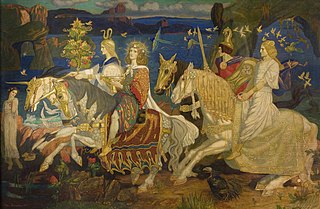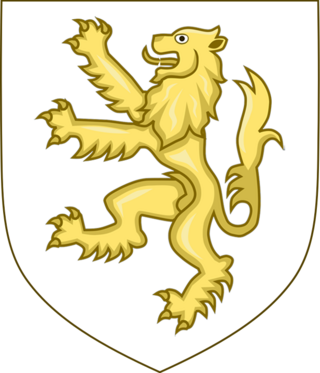
Lugh or Lug is a figure in Irish mythology. A member of the Tuatha Dé Danann, a group of supernatural beings, Lugh is portrayed as a warrior, a king, a master craftsman and a saviour. He is associated with skill and mastery in multiple disciplines, including the arts. Lugh also has associations with oaths, truth, and the law, and therefore with rightful kingship. Lugh is linked with the harvest festival of Lughnasadh, which bears his name. His most common epithets are Lámfada and Samildánach. This has sometimes been anglicised as "Lew of the Long Hand".

The TuathaDé Danann, also known by the earlier name Tuath Dé, are a supernatural race in Irish mythology. Many of them are thought to represent deities of pre-Christian Gaelic Ireland.

The Stone of Scone is an oblong block of red sandstone that was used in the coronation of Scottish monarchs until the 13th century, and thereafter in the coronation of English and later British monarchs. The Stone measures 26 by 16.7 by 10.5 inches and weighs approximately 335 lb. A cross is roughly incised on one surface, and an iron ring at each end aids with transport. Monarchs sat on the Stone of Scone itself, until a wooden platform was added to the Coronation Chair in the 17th century.
Conn Cétchathach, or Conn of the Hundred Battles, son of Fedlimid Rechtmar, was a legendary High King of Ireland who is claimed to be the ancestor of the Connachta, and through his descendant Niall Noígiallach, the Uí Néill dynasties, which dominated Ireland in the early Middle Ages.
In Irish mythology, Bodb Derg or Bodhbh Dearg was a son of Eochaid Garb or the Dagda, and the Dagda's successor as King of the Tuatha Dé Danann.
In Irish mythology, Elatha, Elotha, Elier or Elada was a king of the Fomorians and the father of Bres by Ériu of the Tuatha Dé Danann, as well as Delbaeth, Ogma, Elloth, and the Dagda by an unnamed mother. The imagery surrounding him suggests he may be associated with sources of light and illumination, such as the sun.
Ogma is a god from Irish and Scottish mythology. A member of the Tuatha Dé Danann, he is often considered a deity and may be related to the Gallic god Ogmios. According to the Ogam Tract, he is the inventor of Ogham, the script in which Irish Gaelic was first written.

The Hill of Tara is a hill and ancient ceremonial and burial site near Skryne in County Meath, Ireland. Tradition identifies the hill as the inauguration place and seat of the High Kings of Ireland; it also appears in Irish mythology. Tara consists of numerous monuments and earthworks—dating from the Neolithic to the Iron Age—including a passage tomb, burial mounds, round enclosures, a standing stone, and a ceremonial avenue. There is also a church and graveyard on the hill. Tara forms part of a larger ancient landscape and Tara itself is a protected national monument under the care of the Office of Public Works, an agency of the Irish Government.

In Irish origin myths, Míl Espáine or Míl Espáne is the mythical ancestor of the final inhabitants of Ireland, the "sons of Míl" or Milesians, who represent the vast majority of the Irish Gaels. His father was Bile, son of Breogan. Modern historians believe he is a creation of medieval Irish Christian writers.

The Milesians or sons of Míl are the final race to settle in Ireland, according to the Lebor Gabála Érenn, a medieval Irish Christian history. The Milesians represent the Irish people. They are Gaels who sail to Ireland from Iberia (Hispania) after spending hundreds of years travelling the Earth. When they land in Ireland, they contend with the Tuatha Dé Danann, who represent the Irish pantheon of gods. The two groups agree to divide Ireland between them: the Milesians take the world above, while the Tuath Dé take the world below.
In the Mythological Cycle of early Irish literature, the four treasures of the Tuatha Dé Danann are four magical items which the mythological Tuatha Dé Danann are supposed to have brought with them from the four island cities Murias, Falias, Gorias, and Findias when they arrived in Ireland.
In Irish mythology Fintan mac Bóchra, known as "the Wise", was a seer who accompanied Noah's granddaughter Cessair to Ireland before the deluge. Bóchra may be his mother, or may be a poetic reference to the sea.

The Mythological Cycle is a conventional grouping within Irish mythology. It consists of tales and poems about the god-like Tuatha Dé Danann, who are based on Ireland's pagan deities, and other mythical races such as the Fomorians and the Fir Bolg. It is one of the four main story 'cycles' of early Irish myth and legend, along with the Ulster Cycle, the Fianna Cycle and the Cycles of the Kings. The name "Mythological Cycle" seems to have gained currency with Arbois de Jubainville c. 1881–1883. James MacKillop says the term is now "somewhat awkward", and John T. Koch notes it is "potentially misleading, in that the narratives in question represent only a small part of extant Irish mythology". He prefers T Ó Cathasaigh's name, Cycle of the Gods. Important works in the cycle are the Lebor Gabála Érenn, the Cath Maige Tuired, the Aided Chlainne Lir and Tochmarc Étaíne.
Eochu or Eochaid Feidlech, was a High King of Ireland, according to medieval Irish legends and historical traditions. He is best known as the father of the legendary queen Medb of Connacht.
In Irish mythology Eochaid, son of Erc, son of Rinnal, of the Fir Bolg became High King of Ireland when he overthrew Fodbgen. He was the first king to establish a system of justice in Ireland. No rain fell during his reign, only dew, and there was a harvest every year.

Éber Finn, son of Míl Espáine, was, according to medieval Irish legend and historical tradition, a High King of Ireland and one of the founders of the Milesian lineage, to which medieval genealogists traced all the important Gaelic royal lines.

Érimón, commonly Anglicised as Heremon, son of Míl Espáine, according to medieval Irish legends and historical traditions, was one of the chieftains who took part in the Milesian invasion of Ireland, which conquered the island from the Tuatha Dé Danann, and one of the first Milesian High Kings.
Cairbre Cinnchait or Caitchenn was, according to medieval Irish legend and historical tradition, a High King of Ireland. There is considerable differences in the sources over his ancestry and his place in the traditional sequence of High Kings.
A coronation stone is a stone which has taken part in the ceremony of a monarch’s coronation. These stones were primarily used in medieval Europe, but historical examples exist throughout the world. Stones believed to have been used as coronation stones still exist, but public figures and historians argue about their authenticity and use today. Some are considered by historians to have been invented in the early modern period.










